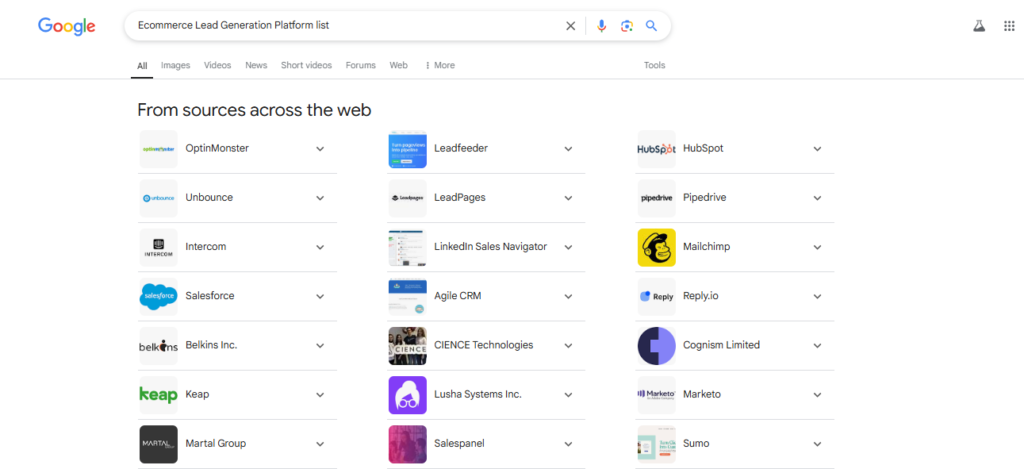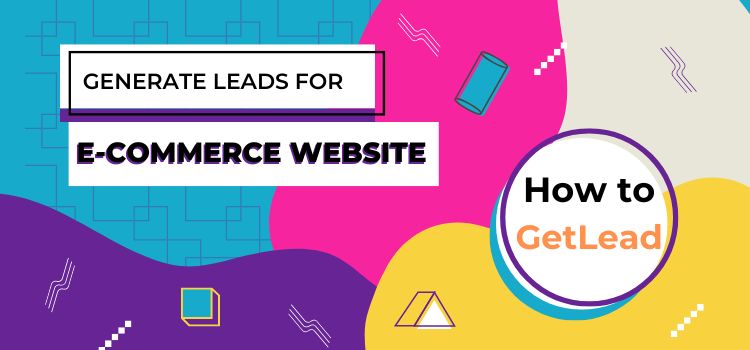Generating leads is essential for any e-commerce business to thrive. A steady flow of potential customers ensures consistent sales and growth. Here’s how you can effectively generate leads for your e-commerce website:
1. Optimize Your Website
- Ensure fast loading speed to reduce bounce rates.
- Make your site mobile-friendly for seamless browsing.
- Use clear call-to-action (CTA) buttons to encourage sign-ups.
- Offer lead capture forms with incentives like discounts.
2. Understanding E-commerce Lead Generation
 E-commerce lead generation refers to the process of attracting potential customers and collecting their information to nurture them into buyers. A lead can be a visitor who subscribes to your newsletter, adds a product to their cart, or engages with your website in a meaningful way.
E-commerce lead generation refers to the process of attracting potential customers and collecting their information to nurture them into buyers. A lead can be a visitor who subscribes to your newsletter, adds a product to their cart, or engages with your website in a meaningful way.
3. Optimizing Your Website for Lead Generation
A well-optimized website is crucial for capturing leads. Here’s how:- Fast Loading Speed: Ensure your website loads quickly to reduce bounce rates.
- Mobile-Friendly Design: Most online shoppers browse on mobile devices.
- Clear Call-to-Actions (CTAs): Use prominent buttons like “Sign Up” or “Get Discounts.”
- User-Friendly Navigation: Make it easy for visitors to find products and information.
- Lead Capture Forms: Offer incentives such as discounts in exchange for email sign-ups.
4. Utilizing SEO for Organic Leads
Search engine optimization (SEO) plays a major role in driving organic traffic to your site. Key strategies include:- Keyword Research: Use tools like Google Keyword Planner to find relevant keywords.
- On-Page SEO: Optimize title tags, meta descriptions, and URLs.
- Quality Content: Create blog posts, product guides, and FAQs.
- Technical SEO: Improve site speed, XML sitemaps, and schema markup.
- Backlink Building: Gain links from reputable websites to boost authority.
5. Leveraging Social Media Marketing
Social media platforms provide an excellent way to generate leads.- Facebook & Instagram Ads: Target specific demographics with lead ads.
- Interactive Content: Use quizzes, polls, and giveaways.
- Shoppable Posts: Allow users to purchase directly from social media.
- Influencer Collaborations: Partner with influencers to drive traffic.
- Engaging Content: Share behind-the-scenes, user-generated content, and testimonials.
6. Running Paid Advertising Campaigns
Paid advertising accelerates lead generation. Popular methods include:- Google Ads: Target users searching for relevant products.
- Facebook Ads: Use custom audiences for retargeting.
- Instagram Ads: Showcase products visually to attract leads.
- YouTube Ads: Educate and inspire potential customers.
- Retargeting Ads: Re-engage visitors who left without purchasing.
7. Email Marketing Strategies
Email marketing remains one of the most effective lead generation tactics.- Lead Magnets: Offer free ebooks, discount codes, or early access.
- Automated Drip Campaigns: Nurture leads with personalized emails.
- Abandoned Cart Emails: Encourage users to complete their purchases.
- Newsletter Campaigns: Keep subscribers engaged with valuable content.
- Exclusive Offers: Reward loyal subscribers with special deals.
8. Content Marketing for Lead Generation
Creating valuable content attracts and LinkedIn nurtures leads.- Blogging: Write product guides, comparisons, and tips.
- Videos: Create tutorials, testimonials, and behind-the-scenes content.
- Infographics: Share visual content that simplifies complex topics.
- Webinars & Live Streams: Engage with potential customers in real time.
- Case Studies: Showcase success stories to build credibility.
9. Influencer and Affiliate Marketing
Collaborating with influencers and affiliates can expand your reach.- Influencer Reviews: Get your products reviewed by popular influencers.
- Affiliate Programs: Offer commissions to affiliates who drive sales.
- Micro-Influencers: Engage smaller influencers with niche audiences.
- Unboxing Videos: Leverage YouTube and Instagram for product exposure.
10. Pros and Cons of Different Lead Generation Strategies
| Lead Generation Strategy |
Pros |
Cons |
|---|---|---|
| SEO (Search Engine Optimization) | Free organic traffic, long-term results | Takes time, requires ongoing optimization |
| Social Media Marketing | High engagement, brand awareness | Needs consistent content and effort |
| Paid Ads (Google, Facebook) | Fast results, highly targeted | Expensive, requires continuous budget |
| Email Marketing | Cost-effective, high conversion rates | Needs an email list, risk of spam filters |
| Content Marketing | Builds trust, improves SEO | Requires time and effort to produce quality content |
| Influencer Marketing | Leverages trust, expands reach | Can be costly, results may vary |
| Affiliate Marketing | Performance-based, low upfront cost | Requires finding the right affiliates |
| Retargeting & Remarketing | Increases conversion rate, re-engages visitors | Can be intrusive if overdone |
11. Conversion Rate Optimization (CRO)
Improving your website’s conversion rate maximizes lead generation.- A/B Testing: Test different CTAs, headlines, and layouts.
- Exit-Intent Popups: Offer discounts before users leave.
- Live Chat Support: Answer queries instantly to capture leads.
- Trust Signals: Display customer reviews, security badges, and testimonials.
- Simplified Checkout Process: Reduce cart abandonment with a seamless checkout.
12. Retargeting and Remarketing Strategies
Not all visitors convert on their first visit, so retargeting helps re-engage them.- Facebook Pixel: Facebook Pixel Track and retarget website visitors.
- Google Remarketing: Show ads to users who previously interacted with your site.
- Email Retargeting: Send personalized offers to past visitors.
- Dynamic Retargeting Ads: Display products users viewed but didn’t purchase.
13. Measuring and Analyzing Lead Generation Success
Tracking your lead generation efforts ensures continuous improvement.- Google Analytics: Monitor traffic, conversions, and user behavior.
- Heatmaps: Use tools like Hotjar to understand user interactions.
- A/B Testing Results: Compare different strategies to see what works best.
- Conversion Tracking: Set up tracking for ads, email campaigns, and landing pages.
- Customer Feedback: Gather insights from surveys and reviews.
Utilize Lead Generation Services
Instead of struggling with DIY lead generation, using professional lead generation services can save time and money. HowToGetLead.com specializes in providing high-quality, targeted leads for roofing businesses across the USA. Their services ensure you get pre-qualified leads who are genuinely interested in your services.14. Conclusion
Generating leads for an e-commerce website requires a multi-faceted approach, combining SEO, content marketing, social media, paid ads, email marketing, and retargeting. By implementing these strategies, you can drive more traffic, capture leads, and ultimately boost sales. Start experimenting with these techniques today and watch your e-commerce business grow!By following this guide, you’ll have a solid foundation for generating leads for your e-commerce website. If you need expert help in building a lead generation strategy, don’t hesitate to reach out!


